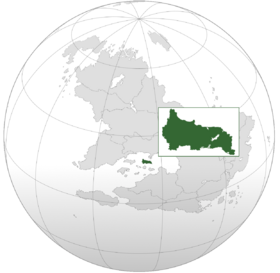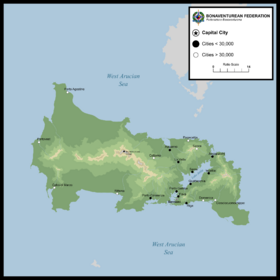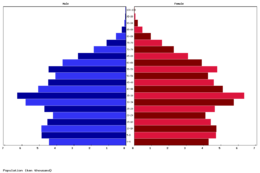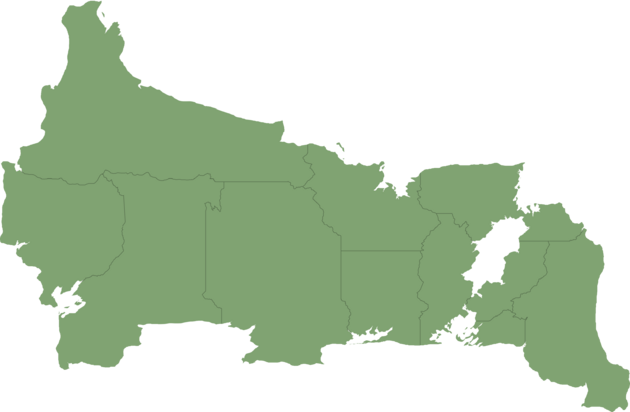Bonaventura
Bonaventurean Federation Vespasian: Federazione Bonaventurana | |
|---|---|
Motto: "Negare e triunfare" (Estmerish: To deny and to triumph) | |
 Location of Bonaventura in the West Arucian Sea in green. | |
 Detailed map of Bonaventure | |
| Capital and | Sermoni |
| Official languages | Vespasian |
| Recognised regional languages | |
| Ethnic groups (2020) |
|
| Demonym(s) | Bonaventurean |
| Government | Federative presidential republic |
• President | Vinicio Nardiello |
• Vice President | Liberio Ceci |
• President of National Assembly | Euseo Di Marino |
| Legislature | National Assembly |
| Formation | |
| Area | |
• | 40,015.36 km2 (15,450.02 sq mi) |
| Population | |
• 2020 estimate | 3,299,035 |
• Density | 82.44/km2 (213.5/sq mi) |
| GDP (PPP) | 2020 estimate |
• Total | $50,378,555,599 |
• Per capita | $15,271 |
| GDP (nominal) | 2020 estimate |
• Total | $26,368,659,217 |
• Per capita | $7,993 |
| HDI (2020) | 0.796 high |
| Currency | Arucian shilling (ſ) (ARS) |
| Date format | dd-mm-yyyy |
| Driving side | right |
| Calling code | +5 |
| Internet TLD | .bv |
Bonaventure (Vespasian: Bonaventura), also known as the Bonaventurean Federation (Vespasian: Federazione Bonaventurana) is a sovereign island nation located in the West Arucian sea, in between the continents of Asteria Superior and Asteria Inferior. Bonaventure has maritime borders with Ardesia to the north, Aucuria to the southeast, Eldmark to the west, and Imagua and the Assimas to the south, with whom Bonaventure has a territory dispute over the small Dunhelm Island. As of 2020, Bonaventure has a population of 3,3 million people, and a land area of 40,015.36 square kilometers, being the second biggest and second most populated of the Arucian islands. The capital and biggest city of Bonaventure is the city of Sermoni, located in the .?.?.? bay, in the southern coast of the island.
The island has been populated by the Natí people since 200 BCE and experience an increase in their population during 9th century CE. During the same time, the Zapoyan Empire landed in Bonaventure's northern coast, and quickly established the land as an important location for the seafare commerce in the Arucian Sea. While the Zapoyan influence in Bonaventure grew exponentially, many other Arucian people such as the Natí and the Marai could be found in the island, given it was the Zapoyan's main commercial point within the Arucian Sea. The island remained under the control of the Zapoyans until Assim Asteris and his expedition first harboured in Bonaventure. The Etrurian occupation of the Assimas Island also drove their attention to the Bonaventure. The first Etrurian settlement in Bonaventure was established in 1523, and the Insular War of 1536, led by Giacomo Borghese, put and end on the Zapoyan rule of the island and settled Bonaventure as the Etrurian colony of New Accadia.
New Accadia remained a colony until October 6th, 1946, when Etruria's defeat in the Solarian War put an end to their colonial empire. Eleven days following its independence, New Accadia was acquired and taken as part of the United Provinces of the Western Arucian Islands. The United Provinces remained united until the departure of Imagua and the Assimas, in 1948, and it dissoluted permanently in 1954, with the departure of Sainte-Chloé and Carucere after a constitutional crisis within the Union. New Accadia carried on the name of United Provinces for about 1 year and 3 months after its independence, when a popular referendum voted that the newly sovereign island would be named after the independence war hero, Quarto Bonaventura.
Bonaventure is a volcanic island that lays on the Arucian faultline, a divergent plate boundry between the .?.?.? and the .?.?.? plates. Such conditions have resulted in the formation of the Iacattuotili Valley, alongside the formation of Lake Attila, the biggest and deepest lake in the Arucian island. This geographic placement, however, has affected Bonaventure with many natural disasters including the 1804 Sermoni earthquake, and the 2020 Mount Micchiano eruption.
Bonaventure has the second biggest nominal GDP amongst the Arucian Nations at $26,3 billion, but the second lowest nominal GDP per capita at $7.993. The nation has experience in the service sector, with emphasis in the tourism and financial services. Bonaventure has been attractive to international investors due to its liberal economy and area size, however the 2020 Mount Micchiano eruption caused a tremendous shock to the national economy, and Bonaventure has been in an extensive economic crisis since then. Bonaventure is a member of the Community of Nations, the Organization of Asterian Nations, and co-founder of the Arucian Cooperation Organization.
Etymology
Bonaventure has gone through some name changes throughout the years prior to its current one. For instance, the first record of a name for the island was Chalma. According to linguists, the name is a reference to the Zapoyan term “Chalmecacihuatl,” which translated to the “Women from Chalmeca,” a Zapoyan deity who was worshiped by merchants as the sister of the merchant god, Yacateuctli, and also as the the goddess of “water and earth.” Following the fall of the Zapoyan Empire and the Etrurian conquest in 1536 saw the island being renamed to “New Accadia,” as a celebration to the several families natural from the Etrurian city of Accadia that arrived in the city of Sermoni in January 1538 to permanently populate the location. The colony would keep its name until October 17th, 1946, when the newley independent nation joined the United Provinces of the West Arucian Islands. The name was a reference to all of the Western Arucian islands that united to establish of the United Provinces.
The current name was a suggestion made by Ireneo Zaccaria, a former history professor in the Sermoni University, when the national government opened a contest to select three names for a referendum to change the name of the Island following the dissolution of the United Provinces in 1954. Amongst the over 100 names submitted, Bonaventura, alongside Nuova Cialma and Azzalia were the selected finalists. Ultimately, the name “Bonaventura” was the most voted and it was officially put into effect in January 1st, 1956. According to Professor Zaccaria, the reason for suggesting the name “Bonaventura” was a way to honor the image and doings of Quarto Bonaventura, a man seen by the people of the island as a war hero, a martyr, and a liberator of Bonaventura during the Independence Wars, on top of having a linguistically meaning “land of good fortune,” as bona seems to be a variant of the Vespasian buona (good), and ventura seems to be a variant of the Vespasian fortuna (luck, good fortune). Some historians also argue that the real reason for choosing the name “Bonaventura” is a reference to the Ship Bonaventura, one of the very first Etrurian expeditions to the island led by captain Benvenuto Viscuso, natural from the small Etrurian city of Paci, who’s patron saint is the catholic Saint Bonaventura; the massive part of historians do not attest for this theory and generally accord with Professor Zaccaria’s explanation instead.
History
Geography
Climate
Biodiversity
Demographics

| Historical population | ||
|---|---|---|
| Year | Pop. | ±% |
| 1765 | 44,883 | — |
| 1775 | 70,250 | +56.5% |
| 1800 | 155,426 | +121.2% |
| 1815 | 220,892 | +42.1% |
| 1832 | 350,051 | +58.5% |
| 1846 | 447,914 | +28.0% |
| 1860 | 583,308 | +30.2% |
| 1877 | 731,648 | +25.4% |
| 1887 | 798,565 | +9.1% |
| 1899 | 953,243 | +19.4% |
| 1910 | 1,118,012 | +17.3% |
| 1920 | 1,299,809 | +16.3% |
| 1930 | 1,543,913 | +18.8% |
| 1940 | 1,869,255 | +21.1% |
| 1950 | 2,210,703 | +18.3% |
| 1960 | 2,349,544 | +6.3% |
| 1970 | 2,712,033 | +15.4% |
| 1980 | 3,196,520 | +17.9% |
| 1990 | 3,522,037 | +10.2% |
| 2000 | 3,808,610 | +8.1% |
| 2010 | 3,725,789 | −2.2% |
| 2020 | 3,299,035 | −11.5% |
The population of Bonaventure, according to the 2020 census made by the Bonaventurean Institute of Geography and Statistics (IBGS), was 3,299,035 habitants (82.4 per square kilometer), with a proportion between men and women as 0.86:1 and over 80% of the population living in the cities. The population is strongly located in the southern region (Rivermouth region), home to over 2 million people, accounting for about 62% of the country's total population. The biggest urban areas of Bonaventure, according to the estimative made by IBGS as of 2020, are the metropolitan areas of the national capital Sermoni (857,732), Fava (392,663), Appano (184,651), Porto Gamba (167,045), and Riga (163,222).
Though Bonaventure is a country of emigration tendencies, immigration has played an important part in the nation’s current demographic makeover. Waves of Vespasians, Carinthians, and Novalians in the 19th century, as well as Carinthians and Novalians again in the 20th century, are amongst the biggest Euclean descendant populations in Bonaventure. In terms of other Asterian people moving into Bonaventure, Ardesia has been a historical point of departure to Bonaventure. For instance, the Zapoyan colonies of the 9th century were the first wave of Ardesian immigration into the island, followed by another mass Ardesian immigration wave between the 1940s and the 1960s. Despite that, Bonaventure has been an emigration country, meaning that it loses more population than it gets. For instance, the current immigration rate of Bonaventure is -1.01 migrant(s) per 1,000 inhabitants. Most of this diaspora is due to better life conditions in neighboring countries, specially in Asteria Superior.
The Bonaventurean population had a significant growth throughout the 20th century, with a significant deacceleration and decrease of population in the 2000s, 2010s, and 2020s. The low birth rate alongside the growing Bonaventurean diaspora has resulted in a recurring negative population growth since the beginning of the 21st century. Nowadays, the birth rate of Bonaventure is 7.5/1,000, amongst the lowest in the world. The life expectancy is of 78,28 years; the expected years of education for Bonaventure is 13.3 years, while the mean years of education is of 11 years; the GDP PPP per capita of Bonaventure is of approximately $15.3 thousands. The Bonaventurean HDI is 0.791, considered high and ranking as the second best in the West Arucian region.
Ethnicities
The island was first inhabited by the Natí people at around the 9th century CE. The Natí people were located mostly on the southwest plains of the Bonaventurean island. The Marai people were also seen to immigrate into Bonaventure, but in less numbers than the Natí. The Marai people concentrated their settlements in the southeast in the Bassa Peninsula. The Zapoyan people, on the other hand, migrated down from Ardesia into Bonaventure, and occupied all of of the Northern coast, as well as the west coast, and the Iacattuotili Valley. The establishment of the Zapoyan Empire in Bonaventure, and the promotion of the island as a commercial hub in the region, the Native Asterians coexisted fairly peacefully.
The arrival of the Eucleans in Bonaventure during the 16th century saw the introduction of White Euclean people in the current demographic layover of Bonaventure. Mostly concentrating their settlements in the southern and eastern coast, the Eucleans were rapid to rule out the native dominion of the land. This led to many native people being killed, dying of because of new diseases, or being enslaved. The Eucleans also introduced Black Bahians into the scene, as Bonaventure became an important point of commerce during the Transvehemens slave trade.
As the Euclean and Bahian populations grew, and the Native Asterians decreased, the birth of a Mixed race (Razza mista) came to be as all three major ethnicities started to coexist and reproduce. Nowadays, the Mixed ethnicity accounts for 37.6% of Bonaventure’s population, the biggest ethnic group in the island. Additionally, the White people account for 27.4%, followed closely by Black Bahians or Bahio-Ventureans at 26.3%, and Native Asterians, most of which are of Zapoyan origins, at 6.2%. Approximately 1.4% of the population is unspecified, while 1.1% are other ethnicities, more often Southern Coians including Senrians and Shangeans.
Religion
Languages
The official language of the Bonaventurean Federation is Vespasian. All government, media, and education are performed in Vespasian. Around 99,4% of the Bonaventure population speaks Venturean Vespasian as their first language. The variation of Venturean Vespasian can be seen between regions, with accents being easily identifiable. For instance, the most widely spread accent in Bonaventure is the Metropolitan accent, spoken in the Rivermouth region. Other widely spread accents in Bonaventure include the Lake accent, spoken by the Lake States population, the Fino accent, spoken mainly in the State of Santa Fina, the Croscian accent, spoken by inhabitants of Nuova Croscia, the Southeast accent, spoken by people from Bociba, Rittona, and Trinità, and the Bassano accent, spoken by the people of Spirito Santo state.
In terms of other national languages, Souther Zapoyan is the most widespread one, with approximately 213 thousand native speakers, mostly concentrated in the Lake Valley region. The Template:WpN is still sparsely spoken by a few hundreds of people in the Southwest region, most of who live in the countryside of their respective states.
Astapasian is widely spoken in the State of Santa Fina, where about 16 thousand people speak it as their native tongue. The Astapasian language developed in the region after masses of Ardesian people migrated to the flatlands of the northwest of Bonaventure, and settled in the region. The city of San Agostino is where the most amount of Astapasian speakers live, but the city of Clemenza di Sant'antonio is considered the cultural center of the Astapasian people.
Cartesian is another language that holds a status of a regional language, being spoken mainly in the State of Nuova Croscia. The waves of Carinthian and Novalian immigrants settled in the west coast of Bonaventure and brought the language to the region. Nowadays, Cartesian is spoken by about 11 thousand people natively, almost all located in Nuova Corsica. The city of Portovest is the cultural haven of the Cartesian language, as well as where the majority of its speakers are located.
Government & Politics
Law
Armed forces
Crime and law enforcement
International relations
Sub-divisions
States
With the permanent dissolution of the United Provinces of the Golden Isles, and the Constitutional reform of 1956, Bonaventure became a federative republic, thus being subdivided into states as opposed to provinces. The first arrangement of the states in 1956 resulted in the creation of 15 states. In 1959, due to the increasing amount of population, political relevancy, and economic importance of the region, the Federal District was created by partitioning the municipalities belonging to the states of San Giorgio and Mission, and assigning it under the administration of the new state, headed by Sermoni, and its new capital city of Teravigo. The remaining four states were former national territories, but they were recently granted statehood due to their population surprising 20,000 people; the order of admission is: Rittona in 1982, Spirito Santo in 1988, Mizzia in 1994, and Ximantuatti in 2000, becoming the 20th and the newest state in Bonaventure.
Cities and Municipalities
| Rank | State | Pop. | |||||||
|---|---|---|---|---|---|---|---|---|---|
 Sermoni  Fava |
1 | Sermoni | Federal District | 857,732 |  Appano  Porto Gamba | ||||
| 2 | Fava | Missioni | 392,663 | ||||||
| 3 | Appano | Poveromo | 184,651 | ||||||
| 4 | Porto Gamba | Santa Croce | 167,045 | ||||||
| 5 | Riga | San Giorgio | 163,222 | ||||||
| 6 | Accapucchi | Montecalvo | 132,029 | ||||||
| 7 | La Valla | Setinattia | 109,937 | ||||||
| 8 | Iecattia | Conucco | 101,838 | ||||||
| 9 | Quattecchia | San Gaetano | 90,224 | ||||||
| 10 | Sacra | Attila | 67,882 | ||||||


